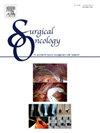局部晚期直肠癌新辅助放化疗是否需要骨盆外侧淋巴结清扫?
IF 2.4
4区 医学
Q3 ONCOLOGY
引用次数: 0
摘要
术前放化疗(CRT)反应是判断盆腔外侧淋巴结(LPN)转移可能性的重要指标。然而,LPN解剖(LPN dissection, lnd)在CRT应答良好患者中的作用尚不清楚。本研究旨在确定对术前CRT反应良好的直肠癌患者的最佳治疗策略。方法本研究是一项多机构回顾性研究,评估局部晚期直肠癌和临床怀疑LPN转移的患者在CRT后行全肠系膜切除术并LPN。根据crt后最大淋巴结直径(截止时间:5 mm)将患者分为两组:良好(n = 38)和不良反应(n = 53)。结果不良反应组(18例,34.0%)slpn转移率显著高于良好反应组(5例,13.2%)(p = 0.024)。反应良好组的5例患者均为低位直肠癌(即肿瘤位于距肛门边缘(AV) 5cm以内)。低位直肠癌是良好应答者LPN转移的唯一显著预测因子(p = 0.004)。然而,CRT前后LPN大小并不能预测本组LPN转移(p分别= 0.947和0.910)。当所有不良反应者和良好反应者,肿瘤位于距AV≤5cm处时,LPN转移诊断的敏感性为100%。结论术前CRT反应良好的直肠癌患者中,病理性LPN转移发生率为13.2%,肿瘤高度是发生LPN转移的重要危险因素。无论术前CRT反应如何,低位直肠肿瘤均可考虑lpd。本文章由计算机程序翻译,如有差异,请以英文原文为准。
Is lateral pelvic lymph node dissection necessary for good responder to neoadjuvant chemoradiation in locally advanced rectal cancer?
Background
Response to preoperative chemoradiation (CRT) is an important indicator of the possibility of lateral pelvic lymph node (LPN) metastasis. However, the effect of LPN dissection (LPND) in good responders to CRT remains unclear. This study aimed to identify the optimal treatment strategy for patients with rectal cancer who respond well to preoperative CRT.
Methods
This multi-institutional retrospective study evaluated patients with locally advanced rectal cancer and clinically suspected LPN metastases who underwent total mesorectal excision with LPND after CRT. The patients were divided into two groups based on the largest lymph node diameter post-CRT (cutoff: 5 mm): good (n = 38) and poor responders (n = 53).
Results
LPN metastasis was significantly higher in poor responders (18 patients, 34.0 %) than in good responders (5 patients, 13.2 %) (p = 0.024). All 5 patients in the good responder group had low rectal cancer (i.e., tumors located within 5 cm from the anal verge (AV)). Low rectal cancer was the only significant predictor for LPN metastasis in good responders (p = 0.004). However, LPN size before and after CRT did not predict LPN metastasis in this group (p = 0.947 and 0.910, respectively). When LPND was indicated for all poor responders and for good responders with tumors located ≤5 cm from the AV, the sensitivity for LPN metastasis diagnosis was 100 %.
Conclusion
Among rectal cancer patients with good response to preoperative CRT, pathological LPN metastasis occurs in 13.2 %, and tumor height is a significant risk factor for LPN metastasis. LPND might be considered for low rectal tumors, regardless of preoperative CRT response.
求助全文
通过发布文献求助,成功后即可免费获取论文全文。
去求助
来源期刊

Surgical Oncology-Oxford
医学-外科
CiteScore
4.50
自引率
0.00%
发文量
169
审稿时长
38 days
期刊介绍:
Surgical Oncology is a peer reviewed journal publishing review articles that contribute to the advancement of knowledge in surgical oncology and related fields of interest. Articles represent a spectrum of current technology in oncology research as well as those concerning clinical trials, surgical technique, methods of investigation and patient evaluation. Surgical Oncology publishes comprehensive Reviews that examine individual topics in considerable detail, in addition to editorials and commentaries which focus on selected papers. The journal also publishes special issues which explore topics of interest to surgical oncologists in great detail - outlining recent advancements and providing readers with the most up to date information.
 求助内容:
求助内容: 应助结果提醒方式:
应助结果提醒方式:


